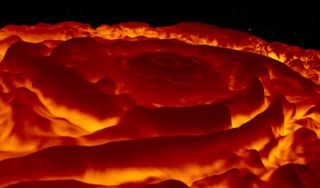These Hellish Storms on Jupiter Are Mesmerizing to Watch
Jupiter's north pole is a mesmerizing stew of glowing storms in a new video released by NASA.
Using data from NASA's Juno mission, researchers created a 3D flyover of the gas giant's north pole in infrared. It shows the turbulent dynamics of the pole, which is topped by a huge cyclone about 2,500 miles (4,000 kilometers) across. Ringing this monster atmospheric storm are eight other cyclones with diameters ranging from 2,500 to 2,900 miles (4,000 to 4,700 km).
The Juno spacecraft launched on Aug. 5, 2011, and entered Jupiter's orbit on July 4, 2016, flying as low as 2,200 miles (3,500 km) over the highest cloud tops of the planet, according to NASA. The goal of the mission is to understand the atmosphere, magnetosphere and gravity fields of the fifth planet from the sun, which, in turn, will help planetary scientists grasp how Jupiter formed and how it has changed over the lifetime of the solar system, according to the space agency. [In Photos: The Most Powerful Storms in the Solar System]
Multilayered view
Juno mission scientists unveiled the new animation Wednesday (April 11) at the European Geosciences Union General Assembly in Vienna. The video uses data collected by the Jovian Infrared Auroral Mapper (JIRAM) aboard Juno. This instrument images the infrared portion of the spectrum, which is invisible to the human eye. By monitoring infrared wavelengths, JIRAM can "see" up to 45 miles (70 km) below the clouds that swirl around Jupiter, according to a statement from NASA's Jet Propulsion Laboratory.

This multilayer view helps scientists understand how Jupiter's interior rotates, study investigator Tristan Guillot, of the University of Côte d'Azur in France, said in that statement.
"Thanks to the amazing increase in accuracy brought by Juno's gravity data, we have essentially solved the issue of how Jupiter rotates: The zones and belts that we see in the atmosphere rotating at different speeds extend to about 1,900 miles (3,000 km)," Guillot said.
Deeper than that, he said, and the powerful magnetic field of Jupiter keeps the largely hydrogen-and-helium atmosphere swirling at a uniform speed.
Sign up for the Live Science daily newsletter now
Get the world’s most fascinating discoveries delivered straight to your inbox.
Jupiter's engine
In other work presented at the Vienna meeting, Juno researchers mapped Jupiter's magnetic field, modeling the deep-interior "dynamo" where the rotation of the planet creates the magnetic field. They discovered surprising complexities and irregularities in the magnetic field, including more complexity in the northern hemisphere than in the southern hemisphere.
Juno will make its 12th data-collecting pass around the planet on May 24, according to NASA.
The animation data used to create the lava-like video of Jupiter's pole came from Juno's fourth pass over the gas giant. Yellow areas are warmer, and thus deeper in the planet's atmosphere; dark areas are colder and higher. According to NASA, the temperature of Jupiter's cloud tops is about minus 234 degrees Fahrenheit (minus 148 degrees Celsius).
"Now our work can really begin in earnest — determining the interior composition of the solar system's largest planet," Guillot said.
Original article on Live Science.

Stephanie Pappas is a contributing writer for Live Science, covering topics ranging from geoscience to archaeology to the human brain and behavior. She was previously a senior writer for Live Science but is now a freelancer based in Denver, Colorado, and regularly contributes to Scientific American and The Monitor, the monthly magazine of the American Psychological Association. Stephanie received a bachelor's degree in psychology from the University of South Carolina and a graduate certificate in science communication from the University of California, Santa Cruz.
Most Popular

